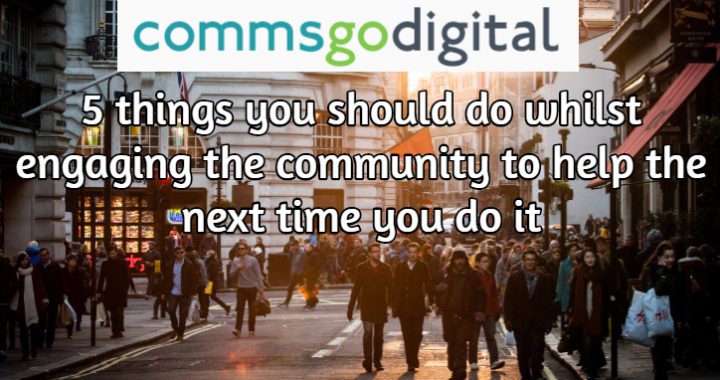Andrew Coulson lists 5 simple things you should be doing whilst you’re engaging the community to help you next time you are out and about.
So you have read the blogs about how to do community engagement, you researched the processes and attended training on the tools and techniques. You may even have been a good community engagement practitioner and written an engagement and communications plan to help those who are walking the journey with you take the right steps but now your there and doing it what can you do during the process, alongside the business stuff, that will help you the next time you have to engage the community.
Here are 5 simple things you should be doing whilst you’re actually engaging the community to help you next time you are out and about.
-
Keep Building Relationships
No brainer. Get to know your community better before, during and after a process. Learn who is who, what their interests are, what pushes their buttons, how do you start conversations with them, who are the key players, groups, influencers, who they shout for on a Saturday afternoon and what their wife/husband/dogs name is! Whilst you’re engaging on your current project don’t forget to take mental notes for next time as you never know when you’ll need to speak to them again or what it could be about.
-
Get the questions and the answers right
Whilst engaging, get to know your audience first before you set questions for them and be meaningful in all you ask of them. Know and be confident about the subject you are engaging on or at least have people with you that you can refer to when needed. Demographic questions have their place and don’t need to be included in everything you do and make sure the questions you ask have no ulterior motive. Keeping surveys short, open and interactive is more likely to get better responses than one with 20 mins of wordy questions and yes/no tick boxes. Next time you ask them to do it they will feel more at ease that it’s not going to sap the life out of them to take part.
-
Go to them during the process
I find that whilst meetings in town halls have their place in community engagement actually meeting out in the community during a process is far more beneficial. It helps you build trust and promote transparency whilst also giving you the opportunity to visit sites you may be engaging about or asking the community to develop and offers the chance to walk and talk whilst looking at the issues that are being raised.
By meeting somewhere they already know or congregate you are more likely to get a better turnout as they may bring family and friends along with them. Whilst the process is running you might learn a certain community group meets at the local pub on a Tuesday night, don’t be afraid to arrange with them to drop in and use that opportunity if it fits your process. They’ll appreciate you coming to them. Also just because it’s not in your engagement plan it doesn’t hurt to pop out of the office and just check in with people during a process.
-
Communication
Whilst communication at the beginning and end of a process is often when it’s at its strongest and all happening due to robust planning, communication during the process needs to be as strong and at a level people are happy with. Once started actually ask people how they wish to be informed of the projects process and how they would like to participate in the future and then add this to your communications plan.
Don’t assume that everyone wants to receive a generic e-newsletter or that everyone is on Facebook to receive the project photo updates when all they want is a simple update poster in their community centre. Collecting this information will not only help during the current process but your communication with them if and when future opportunities arise.
-
Make the process comfortable
Having the ‘right’ refreshments available, in rooms they know and at times they can actually attend goes a long way to making the process more agreeable to the participant and more likely they will come back another time. Fun is also important, where possible inject interactivity, gamification and opportunities to make them smile so that the process leaves a good impression on them for the next one.
Read more: 5 things you should do whilst engaging the community to help the next time you do it
